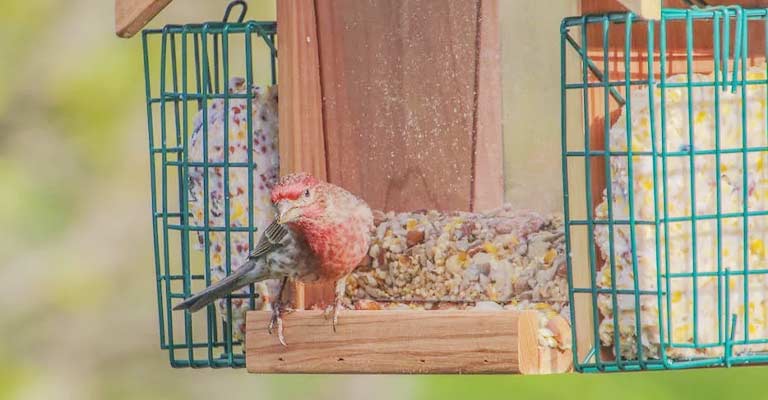Creating a bird-friendly environment is a delightful endeavour, but it comes with the responsibility of managing potential challenges. One significant concern is avoiding the attraction of rats to bird feeders.
While feeding birds brings joy and biodiversity, the presence of rats can lead to health hazards, structural damage, and disruptions in the birding experience. In this pursuit, finding ways to feed birds without attracting rats becomes paramount.
This guide explores effective strategies to maintain a rat-free zone while still providing a nourishing haven for our feathered friends, ensuring a harmonious coexistence between bird enthusiasts and the avian community.

Feed Birds Without Attracting Rats
Ensuring a harmonious coexistence between birds and humans requires thoughtful strategies to feed our avian friends without unintentionally attracting unwanted guests like rats.
Employing methods that deter rats while still offering a nourishing environment for birds is essential.
Here are some effective ways to feed birds without attracting rats
Elevated Feeders
Opt for elevated bird feeders, positioned on poles or hung from branches. This prevents rats from easily accessing the feed, ensuring that only feathered visitors can enjoy the bounty without interference from rodents.
Use Baffles
Install baffles or guards on feeder poles to create an obstacle for rats. These barriers discourage climbing, ensuring that bird feed remains accessible only to its intended recipients.
Regular Cleanup
Keep the feeding area tidy by promptly removing spilt seeds and debris. Rats are attracted to leftovers, and a clean environment reduces the likelihood of their presence while maintaining a healthy feeding space for birds.
Select Seed Wisely
Opt for seed mixes that are less appealing to rats, such as those containing safflower seeds. Birds enjoy them, but rats are less inclined, creating a win-win situation for a rat-resistant bird-feeding solution.
Secure Container Storage
Store bird seed in secure, airtight containers made of metal or sturdy plastic. This prevents rats from accessing and contaminating the stored seed, maintaining a rat-free and bird-friendly feeding station.
Limit Feeding Times
Establish specific feeding times for birds and remove feeders during the night. This reduces the likelihood of attracting nocturnal pests like rats, ensuring that birds enjoy a safe and undisturbed dining experience.
Natural Deterrents
Incorporate natural deterrents like mint or citronella around the feeding area. Rats are known to be averse to these scents, creating a natural barrier without harming the birds’ feeding experience.
What Is The Best Bird Food To Avoid Rats?

Balancing the desire to feed birds with the need to avoid attracting rats requires strategic choices in bird food. By selecting seed varieties that are less appealing to rodents, you can create a bird-friendly environment without inadvertently inviting unwanted guests.
Here are some bird foods that are less likely to attract rats:
Safflower Seeds
Opt for safflower seeds, a nutritious option loved by cardinals, chickadees, and finches. Rats find safflower seeds less appealing, making them an excellent choice for a bird-friendly feeding station that minimizes the risk of attracting rodents.
Thistle (Nyjer) Seeds
Nyjer seeds, also known as thistle seeds, are a favourite among finches. Rats are less attracted to these tiny seeds, making them an ideal choice to entice colourful finches without inviting unwanted rodent guests.
White Proso Millet
White proso millet is a small, nutritious seed enjoyed by a variety of birds like sparrows and doves. It is less likely to attract rats, making it a suitable option for a rat-resistant bird feeding menu.
Millet Mixes
Choose millet mixes that include red millet, white millet, and milo. While favoured by many birds, the combination is less attractive to rats, creating a balanced and bird-friendly feeding solution.
Cracked Corn
Cracked corn is a budget-friendly choice for attracting ground-feeding birds like sparrows and quail. Its larger size and hard texture make it less appealing to rats, ensuring a rat-resistant bird-feeding experience.
Peanuts in the Shell
Whole peanuts in the shell provide a protein-rich option for birds like woodpeckers and jays. Rats are less likely to target peanuts in the shell, making them a suitable choice for a rat-resistant bird menu.
Sunflower Hearts
Sunflower hearts, or hulled sunflower seeds, are a mess-free alternative loved by a variety of birds. They offer the nutritional benefits of sunflower seeds without the shells, reducing the risk of attracting rats.
Why Do You Need To Keep Rats Away From Your Feeders?

Maintaining a bird-friendly environment involves more than just providing food; it also requires keeping unwanted guests, particularly rats, away from feeders.
Here are some compelling reasons why it’s crucial to deter rats from your bird feeding stations:
Health Concerns
Rats carry diseases that can pose health risks to both humans and birds. By preventing rats from accessing feeders, you reduce the potential for the spread of harmful pathogens, creating a safer environment for everyone.
Protecting Birds
Rats can disturb nesting areas, consume bird eggs, and even prey on nestlings. By keeping rats away from feeders, you help protect the well-being and reproductive success of the bird populations in your area.
Preventing Contamination
Rats can contaminate bird food with urine and faeces, introducing harmful bacteria. By deterring rats, you ensure that the birdseed remains clean and uncontaminated, promoting the overall health of the birds you aim to attract.
Avoiding Structural Damage
Rats are notorious for their gnawing habits, and they can cause structural damage to feeders, poles, and nearby structures. By keeping rats away, you safeguard your bird-feeding infrastructure from potential destruction.
Reducing Competition
Rats are opportunistic feeders and can quickly deplete bird feeders, leaving little for the intended avian visitors. By minimizing rat access, you ensure that birds have ample access to the food you provide, fostering a vibrant and active birding environment.
Preserving Landscaping
Rats can wreak havoc on gardens and landscaping in their search for food. By discouraging rats from your feeders, you contribute to the preservation of your outdoor spaces, maintaining a harmonious balance between the natural world and human habitation.
Enhancing Aesthetics
Rats are generally considered unwelcome guests in outdoor spaces. By keeping them away from feeders, you contribute to a more aesthetically pleasing environment, allowing birdwatchers to enjoy the beauty of birds without the intrusion of rodents.
In essence, deterring rats from bird feeders is a multifaceted approach that not only protects the health of both humans and birds but also contributes to the overall well-being of the outdoor ecosystem.
It ensures that your efforts to attract and nurture birds remain a positive and enriching experience for all involved.
FAQs
Are there specific bird foods that rats find less appealing?
Yes, choosing seed varieties like safflower seeds, thistle seeds (Nyjer), and white proso millet can be less attractive to rats while still being enjoyed by a variety of birds.
What is the best way to store birdseed to avoid attracting rats?
Store birdseed in airtight containers, elevated off the ground, and away from walls. Regularly check for signs of moisture or spoilage to maintain a rat-resistant feeding environment.
Can rats damage bird feeders?
Yes, rats can cause structural damage to bird feeders, poles, and nearby structures due to their gnawing habits. Preventing rat access helps safeguard your bird-feeding infrastructure.
How can I deter rats without harming birds?
Use natural deterrents like mint or citronella around the feeding area, and avoid using harmful rodenticides. Creating physical barriers and maintaining a clean feeding space are effective and bird-friendly deterrent methods.
Is it possible to feed birds without also feeding rats?
Absolutely. By implementing strategic methods like elevated feeders, careful birdseed storage, and natural deterrents, you can maintain a rat-free zone while still providing a nourishing environment for birds.
Conclusion
In cultivating a bird-friendly space without inviting unwanted rodents, we contribute to the well-being of both birds and our living environments.
The careful selection of bird foods, strategic feeder placement, and regular maintenance are key aspects of this endeavour.
By employing these methods, we not only protect the health and safety of birds but also safeguard our outdoor spaces from potential damage.
Ultimately, the joy of birdwatching becomes a shared experience, uninterrupted by the challenges of unwanted pests.
In feeding birds without attracting rats, we create a sanctuary that fosters an appreciation for nature’s beauty while respecting the delicate balance of our shared ecosystems.